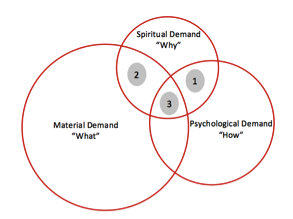Seeking Growth Opportunities Based on Market Demand Model
Note: companies and industries mentioned in the following article are defined within the scope of innovative business models aiming for social and environmental impact.
Along with the rising attention towards public benefits, people start to rethink how to transform such attention into practice. Consequently, an increasing number of interesting social innovation business models (SIBM) has emerged. In B2C business, SIBMs are often faced with similar challenges. The root cause of these challenges is a lack of understanding of different levels of market demand.
The B2C market embeds three layers of demands:
- Material or rigid demand, e.g. clothes, food, housing, transportation, health, safety, etc. – it answers the question of “What?”
- Spiritual demand, e.g. helping others, protecting environment, being a respectful person, serving a long-lasting cause, etc. – it answers the question of “Why?”
- Psychological demand, e.g. fashion, fun, sense of belonging, sense of achievement, etc. – it answers the question of “How?”
Current SIBMs often stem from an observed spiritual demand, and then think about questions as what to produce and how to attract the customers. For example, in disaster relief, NGOs may spot local ethnic group’s skill in making unique embroidery. Then they would think of producing such handicraft works and exporting overseas. That makes a typical SIBM.
The more layers of demands an SIBM meets, the stronger its market base is, which means higher customer loyalty and better capacity for sustainable development. Companies should be aware that the market size for material demands is the largest among the three. So a product absent of solid utility, despite having a good cause or a fun way to attract attention, will eventually face a low consumer / user loyalty, causing threat to its sustainability in the long run.
Internet-based business models, a typical example for type ①, often adopt interactive web design or mobile games to satisfy users’ psychological demand and attract traffic. Corporates would then use the traffic for their brand exposure and eventually become payers. These companies are very good at leveraging on the interactive web design or new media promotion to come up with innovative products. However, they often face a common constraint, i.e., failure to retain customers. In reality, the business model mentioned above exhibits passive effects. For instance, people will respond when a social welfare platform is sending donation ads to them, but few will proactively search the related info and make donation. Or, people will not use the mobile app after it was first downloaded. Taking mature internet-based business models (e.g., dianping.com; qunaer.com) as reference, how to provide users with the most needed and valuable information and service in order to retain customers is worth type ① SIBMs thinking.
Comparatively, type ② SIBMs are much closer to having a mature business model by selling solid products. Examples are handcrafts by ethnic groups, organic agriculture products, art works by disadvantaged children, etc. On one side, to prepare for the mass production, these companies need to understand demand of different market segments, define market position, and have good supply and distribution. On the other side, they need to focus on product branding as well as promotion to elevate its overall performance. They can promote brand story and minimize the advertising cost by using new media tools such as weibo, weixin, and micro movie. All these efforts will help to realize the business upgrade from type ② to type ③.
At the current stage, Type ③ SBIMs embodying all 3 layers of demand are rarely seen in China. But there are some successful stories worthy of reference. For example, TOM’s shoes and its story of “one for one” – if you buy one pair of shoes, TOM’s will give away one pair for free to children in Africa. TOM’s possesses a very clear brand positioning: it is everyone’s material needs to wear shoes. And because of the good quality, the products are already competitive no matter the consumers will buy in the story or not. Besides, the slogan “One for One” plus the fresh design and advanced promotion have turned TOM’s shoes into a fashion and satisfied the psychological demand.
In order to better prepare for long-term development, NGOs seeking to transform into social enterprises or SIBM endeavoring to refine their current business model, could reflect on their competitiveness and think about growth opportunities based on the three types of models.

